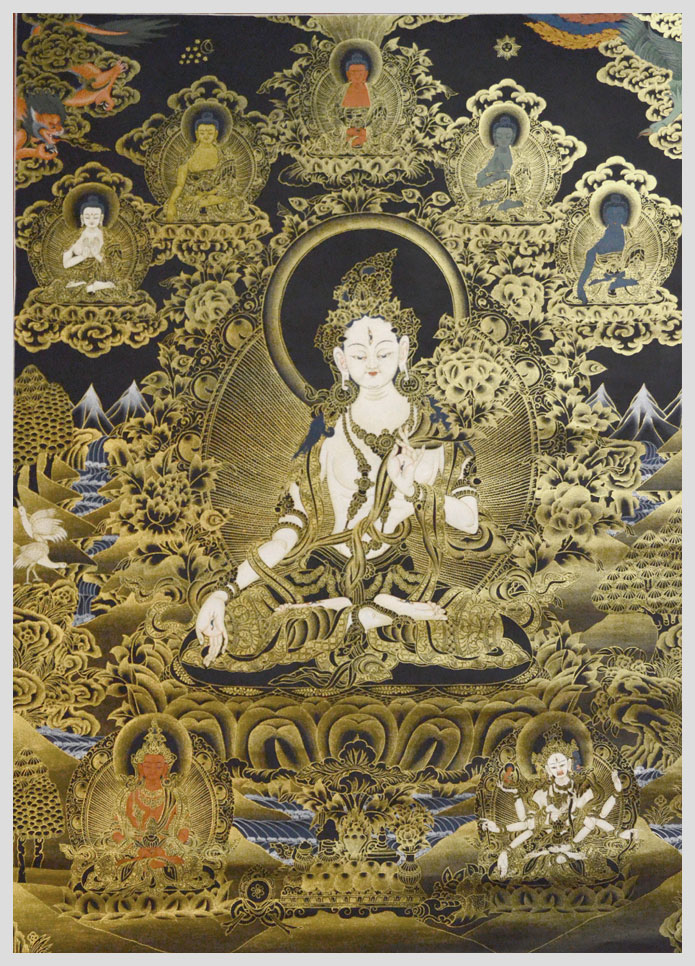

Tibetan Thangka White Tara
Tibetan Thangka White Tara is painted on cotton canvas. White Tara’s embodiment of peace directed through loving compassion. From her serenity, she lends grace and dignity to situations and encourages the good to arise in all circumstances and situations. She perpetuates the Four Measureless States of Loving Kindness, Compassion, Sympathetic Joy, Equanimity with reference to the past present, and future circumstances. She also helps bestow longevity.
The iconography of White Tara
Sita Tara, popularly known as White Tara. She has emanated from Avalokiteshvara & in the Nepali Transcendent Buddha tradition is the consort of Vairochana, the central Transcendent Buddha. Her inner virtue of loving compassion is magnified by the simplicity of her presentation.
White Tara is an important Vajrayana Buddhist figure since she embodies the principle of loving-kindness, which is the central quality in the altruistic Bodhisattva presented through Mahayana Buddhism. Her main emblem is the Pink Lotus representing this main quality.
Her left hand is gracefully lowered in an empty open palm boon granting gesture. White Tara has a blooming pink lotus & an unopened bud on either side of her body. The lotus in the painting is stylized as a peony & a chrysanthemum to provide artistic contrast with her lotus throne. The open blossom represents the present and the bud represents the future situations & Buddhas yet to be born. The future also refers to beneficial changes in circumstances that she will help bring about. Her right-hand wisdom hand is in the gesture of giving refuge.
The word refuge refers to the teaching of compassionate understanding which she imparts. The third finger touches the thumb to create a circle representing the union of wisdom and compassion, and the three extended fingers symbolize the Three Jewels of Buddhism
- The Buddha States
- The Body of teachings
- The Principles of the Universal Form
The same hand holds the stem of a blue lotus representing change. The lower part of the stem below the bend represents the root of the lotus in the mud. The allegory of the Lotus refers to something that grows from the obscurity of the mud & which eventually bursts open in the light. The lotus journey is one of inner awakening & enlightenment analogous to the human spirit. Buddhism shows us how to grow towards the light with profound teachings which help us to navigate away from burdens and sufferings which we may have by being materially-minded, bitter & confused.
There is a lotus on her diadem bearing the Wish-Granting Gem surrounded by an aureole of fire symbolizing auspicious blessings. The extra eye on her forehead, on the palms of her hands & the soles of her feet, represent her ability to see and understand the sufferings of all beings & her omniscient compassion toward the suffering. Avalokiteshvara her progenitor also has a white body & extra eyes. The eyes denote psychic & supernatural power.
The rainbow-colored leggings represent mastery of Boddhi Nature & a manifestation of the Sambhogakaya. The dark blue layer of clothing signifies Mantrayana practice. She is upon a white moon disk & has an orange sun aureole to representing her emanation their melting point.
There is a branch of an Ashoka tree in the foreground. The word Ashoka means ‘without sorrow’ in other words she has no regrets about her behavior. The tree linked to the Vedic God of love & sexual union Kamadeva which blossoms when a virtuous lady touches it.
The triangular diamond rock formation in the foreground represents the Source of Reality out of which deities arise & which is generated from emptiness by the seed syllable E. In the Indian language is a Triangular shaped letter D & so expressed in the triangular rock formations.
Tara’s are difficult to place being neither Deity nor Dakini. Tara’s are commonly described as female emanations and aides of Buddhas. Deities tend to have consorts with whom they are having sexual intercourse. She has a special association with the Pink lotus which represents the arising of wisdom from the obscure depths of the mud and the flowering of the awoken wisdom.
The mud symbolized the primeval state. As with the other emanations of Tara, she has come into being from the teardrop of Avalokateshwara the great Bodhisattva of compassion.
Why Pray White Tara?
Pray to White Tara for protection, healing, and immortality. She gives healing to our wounds, either it is the unhappy mind or physically ill bodies.
Tara, like a mother to her son, is very similar to the sentient beings. She quickly fulfills our wishes and brings us happiness and long life, as well as help us grow wisdom.
One has the power to eliminate barriers to your life and to extend your life by taking refuge in Tara and by practicing meditation, visualization, and having confidence.
The mantra of White Tara
Om Tare Tuttare Ture Mama Ayur Punye Jnana Pushtim Kuru Ye Soha











